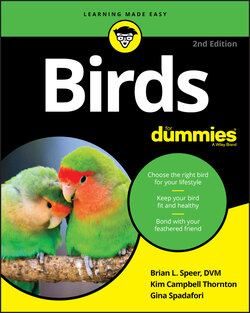Читать книгу Birds For Dummies - Gina Spadafori - Страница 15
The beauty of birds
ОглавлениеLet’s face it: Humans are plain. Oh sure, we have some different skin tones and different hair and eye colors, but put us next to birds, and we have to admit to being pretty dull. And that’s probably one reason why humans appreciate the beauty of birds and why our history with them in close company spans hundreds of years — we just want to be able to gaze upon (or wear) their glorious feathers.
Is it any surprise that some of the more popular pet birds are also the flashiest? The beautiful macaws — the scarlet, the blue-and-gold, and the giant blue hyacinth — are breathtaking to behold, as are their glorious smaller relatives, such as the dazzling sun conure, with a beautiful complement of sun-yellow feathers. And non-parrot species are not to be left out! Just consider the beauty of some of our fancy chicken and waterfowl breeds, as well as prize pigeons. Even smaller birds are prized for their plumage. From a simple singer discovered on a far island, the canary has been bred into all kinds of fancy feathered forms.
The lust for beauty spelled extinction for more than a few species of birds, ruthlessly slaughtered for feathers to adorn ladies’ hats in the last century — as many as five million a year died for their plumage. Among the victims: one of the only two parrot species native to the United States, the Carolina parakeet. By the turn of the century, groups such as the Audubon Society were working to stop the killings. Too late for the Carolina parakeet, though: The last one died in the Cincinnati Zoo in 1918.
How beautiful do humans consider birds? So much that if you’re trying to attract attention to a product or service, a picture of a bird typically works wonders. The eye-catching potential of birds makes them popular with the folks in the advertising and marketing businesses. Fans of the sketch comedy TV series Portlandia may recall the catchphrase “Put a bird on it,” satirizing the trend toward avian motifs. Brian, who always has his eye out for birds, has noticed that about a quarter of the booths at veterinary conferences use birds in their displays, even if birds can’t use the products!
The Latin term rara avis, meaning “rare bird,” is often used to reference an unusual or unique person or object. Roman poet Juvenal is credited with it in a sentence describing “a bird as rare upon the earth as a black swan.”
